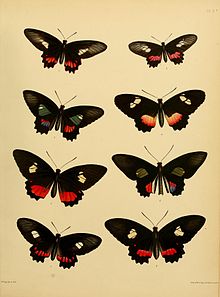Parides lysander
| Lysander cattleheart | |
|---|---|

| |
| Plate accompanying the original description in Cramer and Stoll's Uitlandsche Kapellen, P. lysander top left and bottom right | |
| Scientific classification | |
| Kingdom: | Animalia
|
| Phylum: | Arthropoda
|
| Class: | Insecta
|
| Order: | |
| Family: | Papilionidae
|
| Genus: | |
| Species: | P. lysander
|
| Binomial name | |
| Parides lysander (Cramer, 1775)
| |
| Synonyms | |
| |
Parides lysander, the Lysander cattleheart, is a species of butterfly in the family Papilionidae. It is found in the Neotropical realm.
The larvae feed on Aristolochia species including , , A. littoralis, , and .

Subspecies[]
- P. l. lysander Guianas
- P. l. parsodes (Gray, [1853]) Brazil (Pará)
- P. l. brissonius (Hübner, [1819]) Venezuela, Colombia, Ecuador, S.Peru, Brazil (Amazonas)
- P. l. mattogrossensis (Talbot, 1928) Brazil (Mato Grosso)
- P. l. antalcidas Tyler, Brown & Wilson, 1994 Brazil (Pará)
- P. l. orinocoensis Constantino, Le Crom & Salazar, 2002 Colombia
Description from Seitz[]
P. lysander Cr. (= phrynichus Fldr.). Male with white scent-wool in the fold of the hindwing. Outer margin of the forewing in the female rounded; the last two red spots on the hindwing separated, standing obliquely one under the other; female-f. parsodes Gray (= sonoria Gray) has a large white area on the forewing, composed of several spots: in the female -f. arbates Stoll (= anaximenes Fldr.) the forewing has only one white spot; whilst in the female-f. brissonius Gray (5b) the forewing has no white spot at all. A male with yellow instead of red spots on the forewing has been described as ab. bari Oberth. — This species is known from the whole of the Amazon, East Peru and East Ecuador, as well as from the Guianas and Bogota; it has not hitherto been found in Bolivia nor in Brazil proper. It is a swamp species and flies heavily over the wettest places in the shade of the woods.[1]
Description from Rothschild and Jordan (1906)[]
A full description is provided by Rothschild, W. and Jordan, K. (1906)[2]
Taxonomy[]
Parides lysander is a member of the aeneas species group:[3]
The members are
- Parides aeneas
- Parides aglaope
- Parides burchellanus
- Parides echemon
- Parides eurimedes – mylotes cattleheart, Arcas cattleheart, pink-checked cattleheart, or true cattleheart
- Parides lysander
- Parides neophilus – spear-winged cattleheart
- Parides orellana
- Parides panthonus – panthonus cattleheart
- Parides tros
- Parides zacynthus
References[]
- ^ Seitz, A. ed. Band 1: Abt. 1, Die Großschmetterlinge des palaearktischen Faunengebietes, Die palaearktischen Tagfalter, 1909, 379 Seiten, mit 89 kolorierten Tafeln (3470 Figuren)
 This article incorporates text from this source, which is in the public domain.
This article incorporates text from this source, which is in the public domain.
- ^ Rothschild, W. and Jordan, K. (1906). A revision of the American Papilios. Novitates Zoologicae 13: 411-752. (Facsimile edition ed. P.H. Arnaud, 1967) and online
- ^ Edwin Möhn, 2007 Butterflies of the World, Part 26: Papilionidae XIII. Parides Verlag Goecke & Evers Verlag Goecke & Evers ISBN 9783937783277
- Collins, N. Mark; Morris, Michael G. (1985). Threatened Swallowtail Butterflies of the World: The IUCN Red Data Book. Gland & Cambridge: IUCN. ISBN 978-2-88032-603-6 – via Biodiversity Heritage Library.
- Lewis, H. L., 1974 Butterflies of the World ISBN 0-245-52097-X Page 26, figure 14
| Wikimedia Commons has media related to Parides lysander. |
- Butterflies described in 1775
- Parides
- Papilionidae of South America
- Taxa named by Pieter Cramer



